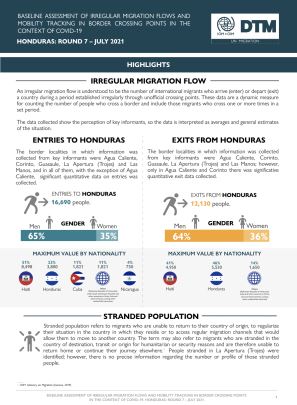-
Countries
-
Data and Analysis
-
Special Focus
-
Crisis Responses
Honduras-Baseline assessment of migration flows and mobiity tracking within the context of COVID-19 report #7 (July, 2021)

Contact
Marisol Calix mcalix@iom.int
Language
English
Location
Honduras
Period Covered
Jul 01 2021
Jul 31 2021
Activity
- Flow Monitoring Survey
- Flow Monitoring
- Migrants presence
- Baseline Assessment
- Event Tracking
The largest irregular migration flow into Honduras is through the southern borders of the country, mainly through La Apertura (Trojes), where the migration phenomenon can be observed in the streets of the communities of Cifuentes and Mata Guineo, mostly with extraregional migrants from Haiti and Cuba, in route to the United States. Extraregional irregular migration has been increasing in recent months, and the entry of Haitians in family groups is noteworthy.
The local government of Trojes has taken drastic measures in relation to the transit of migrants through the municipality, as indications have been issued to reduce the irregular entry of migrants into Honduran territory2. These measures include the prohibition of the use of public transportation and lodging services.
On the other hand, irregular migration in the department of El Paraíso has had a mainly economic impact on the communities, as the illegal trafficking of migrants has become an alternative means of livelihood for these populations and local businesses have been able to increase the cost of products by selling in dollars. The extraregional migrant population is a victim of fraud and in response to this problem, the neighbors of the transit communities have joined together to defend the human rights of migrants and thus prevent persecution against them.
As part of the response to the transit of extraregional migration in Honduras, the National Migration Institute (INM), specifically at its headquarters in Choluteca, grants a "Salvoconducto" (order of expulsion from the country) with a payment of $190. This document is a fine for entering the country irregularly, the charge is stipulated in the Regulations of the Migration Law, Article 136, paragraph 5, and applies without exception to all persons. The expulsion order does not specify the border post through which the migrant must leave the country, this allows migrants to transit within Honduras in a safer way and to leave the country within 3 days.
At the same time, Honduran nationals continue to position themselves as one of the main outgoing migration flows. The search for better socioeconomic conditions and displacement due to violence continue to be the main reasons for Honduran migration. Particularly, persecution and threats from gangs against men under 17 years of age have intensified, forcing this population to migrate in an irregular manner due to internal displacement.